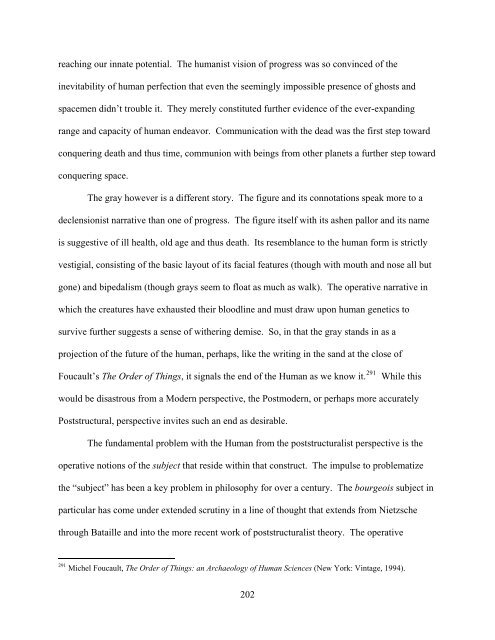A Genealogy of the Extraterrestrial in American Culture
A Genealogy of the Extraterrestrial in American Culture
A Genealogy of the Extraterrestrial in American Culture
You also want an ePaper? Increase the reach of your titles
YUMPU automatically turns print PDFs into web optimized ePapers that Google loves.
each<strong>in</strong>g our <strong>in</strong>nate potential. The humanist vision <strong>of</strong> progress was so conv<strong>in</strong>ced <strong>of</strong> <strong>the</strong><br />
<strong>in</strong>evitability <strong>of</strong> human perfection that even <strong>the</strong> seem<strong>in</strong>gly impossible presence <strong>of</strong> ghosts and<br />
spacemen didn’t trouble it. They merely constituted fur<strong>the</strong>r evidence <strong>of</strong> <strong>the</strong> ever-expand<strong>in</strong>g<br />
range and capacity <strong>of</strong> human endeavor. Communication with <strong>the</strong> dead was <strong>the</strong> first step toward<br />
conquer<strong>in</strong>g death and thus time, communion with be<strong>in</strong>gs from o<strong>the</strong>r planets a fur<strong>the</strong>r step toward<br />
conquer<strong>in</strong>g space.<br />
The gray however is a different story. The figure and its connotations speak more to a<br />
declensionist narrative than one <strong>of</strong> progress. The figure itself with its ashen pallor and its name<br />
is suggestive <strong>of</strong> ill health, old age and thus death. Its resemblance to <strong>the</strong> human form is strictly<br />
vestigial, consist<strong>in</strong>g <strong>of</strong> <strong>the</strong> basic layout <strong>of</strong> its facial features (though with mouth and nose all but<br />
gone) and bipedalism (though grays seem to float as much as walk). The operative narrative <strong>in</strong><br />
which <strong>the</strong> creatures have exhausted <strong>the</strong>ir bloodl<strong>in</strong>e and must draw upon human genetics to<br />
survive fur<strong>the</strong>r suggests a sense <strong>of</strong> wi<strong>the</strong>r<strong>in</strong>g demise. So, <strong>in</strong> that <strong>the</strong> gray stands <strong>in</strong> as a<br />
projection <strong>of</strong> <strong>the</strong> future <strong>of</strong> <strong>the</strong> human, perhaps, like <strong>the</strong> writ<strong>in</strong>g <strong>in</strong> <strong>the</strong> sand at <strong>the</strong> close <strong>of</strong><br />
Foucault’s The Order <strong>of</strong> Th<strong>in</strong>gs, it signals <strong>the</strong> end <strong>of</strong> <strong>the</strong> Human as we know it. 291<br />
While this<br />
would be disastrous from a Modern perspective, <strong>the</strong> Postmodern, or perhaps more accurately<br />
Poststructural, perspective <strong>in</strong>vites such an end as desirable.<br />
The fundamental problem with <strong>the</strong> Human from <strong>the</strong> poststructuralist perspective is <strong>the</strong><br />
operative notions <strong>of</strong> <strong>the</strong> subject that reside with<strong>in</strong> that construct. The impulse to problematize<br />
<strong>the</strong> “subject” has been a key problem <strong>in</strong> philosophy for over a century. The bourgeois subject <strong>in</strong><br />
particular has come under extended scrut<strong>in</strong>y <strong>in</strong> a l<strong>in</strong>e <strong>of</strong> thought that extends from Nietzsche<br />
through Bataille and <strong>in</strong>to <strong>the</strong> more recent work <strong>of</strong> poststructuralist <strong>the</strong>ory. The operative<br />
291 Michel Foucault, The Order <strong>of</strong> Th<strong>in</strong>gs: an Archaeology <strong>of</strong> Human Sciences (New York: V<strong>in</strong>tage, 1994).<br />
202















